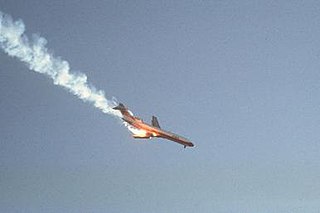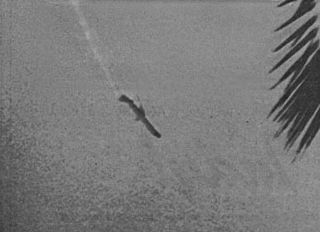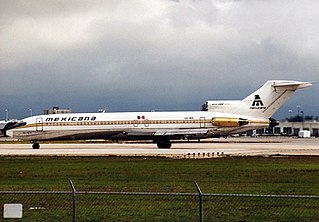This is a list of aviation-related events from 1980.

Pacific Southwest Airlines Flight 182 was a scheduled flight of Pacific Southwest Airlines (PSA) from Sacramento to San Diego with a stopover at Los Angeles. On September 25, 1978, the Boeing 727-214 serving the flight, registration of N533PS, collided with a private Cessna 172 light aircraft, registration N7711G, over San Diego, California. It was Pacific Southwest Airlines' first fatal accident, and it remains the deadliest air disaster in California history. At the time, it was the deadliest air crash to occur in the United States, and remained so until American Airlines Flight 191 crashed in May 1979.
This is a list of aviation-related events from 1969.
This is a list of aviation-related events from 1972.
This is a list of aviation-related events from 1971.
This is a list of aviation-related events from 1977.
This is a list of aviation-related events from 1978.
This is a list of aviation-related events from 1979.

Aeroméxico Flight 498 was a scheduled commercial flight from Mexico City, Mexico, to Los Angeles, California, United States, with several intermediate stops. On Sunday, August 31, 1986, the McDonnell Douglas DC-9 operating the flight was clipped in the tail section by N4891F, a Piper PA-28-181 Cherokee owned by the Kramer family, and crashed into the Los Angeles suburb of Cerritos, killing all 64 on the DC-9, all three on the Piper and an additional 15 people on the ground. Eight on the ground also sustained minor injuries. Blame was assessed equally on the Federal Aviation Administration (FAA) and the pilot of the Cherokee. No fault was found with the DC-9 or the actions of its crew.

Helios Airways Flight 522 was a scheduled passenger flight from Larnaca, Cyprus, to Prague, Czech Republic, with a stopover in Athens, Greece. Shortly after take-off on 14 August 2005, air traffic control (ATC) lost contact with the aircraft operating the flight, named Olympia; it eventually crashed near Grammatiko, Greece, killing all 121 passengers and crew on board. It is the deadliest aviation accident in Greek history.

An airstair is a set of steps built into an aircraft so that passengers may board and alight the aircraft. The stairs are often built into a clamshell-style door on the aircraft. Airstairs eliminate the need for passengers to use a mobile stairway or jetway to board or exit the aircraft, providing more independence from ground services. Some of the earliest aircraft to feature airstairs were the Martin 2-0-2 and Martin 4-0-4. Some models of the Douglas DC-3 were also retrofitted with airstairs. As airport infrastructure has developed, the need for airstairs has decreased, as jetways or mobile stairways are often available.

Mexicana de Aviación Flight 940, operated by Mexicana de Aviación, was a scheduled international flight from Mexico City to Los Angeles with stopovers in Puerto Vallarta and Mazatlán on March 31, 1986, utilizing a Boeing 727-200 registered as XA-MEM, when the plane crashed into El Carbón, a mountain in the Sierra Madre Occidental mountain range northwest of Mexico City, killing everyone on board. With 167 deaths, the crash of Flight 940 is the deadliest aviation disaster ever to occur on Mexican soil, and the deadliest involving a Boeing 727.

Iran Air Flight 277 was a scheduled Iran Air flight from Mehrabad International Airport, Tehran to Urmia Airport, Iran. On January 9, 2011, the Boeing 727 serving the flight crashed after an aborted approach to Urmia Airport in poor weather. Of the 105 people on board, 78 were killed. The official investigation concluded that icing conditions and incorrect engine management by the crew led to a double engine flame-out, loss of altitude and impact with the ground.

On 8 July 2011, Hewa Bora Airways Flight 952, a Boeing 727 passenger jet on a domestic flight from Kinshasa, to Kisangani, Democratic Republic of the Congo (DRC), crashed on final approach at Kisangani, killing 74 of the 118 people on board.

Transportes Aéreos Nacionales SA, also known as TAN Airlines, was a Honduran airline, headquartered at the Edificio TAN in Tegucigalpa. The carrier was set up in 1947 and merged into SAHSA, another Honduran airline, in November 1991.










